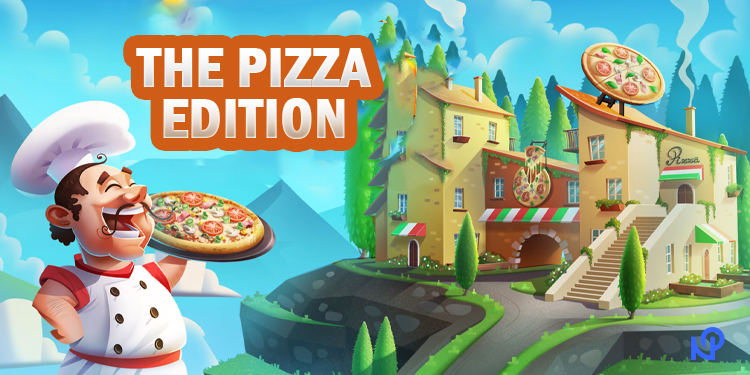Business
The Pizza Edition: A Delectable Dive into the World of Pizza
Published
11 months agoon
By
Admin
The Pizza Edition: A Delectable Dive into the World of Pizza, Pizza. The word alone conjures images of gooey cheese, tangy tomato sauce, and a crispy crust. It’s a universal favorite, transcending cultures and regions. In this edition, we explore the fascinating history, the art of making pizza, its global variations, and answer some frequently asked questions about this beloved dish.
A Brief History of Pizza
The origins of pizza trace back to ancient civilizations. The Greeks and Egyptians had flatbreads topped with various ingredients. However, the modern pizza we know and love originated in Naples, Italy, in the 18th and 19th centuries. The Margherita pizza, named after Queen Margherita of Savoy, was created in 1889 to honor her visit. This pizza, with its basil, mozzarella, and tomato toppings, represented the colors of the Italian flag.
Pizza Goes Global
Pizza’s journey from a local Neapolitan delicacy to a global phenomenon began with Italian immigrants bringing their recipes to the United States in the late 19th century. The first pizzeria in the U.S., Lombardi’s, opened in New York City in 1905. From there, pizza’s popularity exploded, adapting to local tastes and ingredients, resulting in unique styles across the world.
The Art of Pizza Making
Making a perfect pizza is both a science and an art. Here’s a breakdown of the essential components:
The Dough
The foundation of any great pizza is the dough. Traditional Neapolitan pizza dough is made from just four ingredients: flour, water, salt, and yeast. The dough is mixed, kneaded, and allowed to ferment for several hours, developing a complex flavor and chewy texture.
Tips for Perfect Dough
- Use High-Quality Flour: Opt for ’00’ flour, which is finely milled and gives the dough a light, airy texture.
- Proper Fermentation: Allow the dough to ferment slowly, ideally overnight, to enhance the flavor.
- Kneading Technique: Knead the dough until it’s smooth and elastic. This develops the gluten, giving the crust its structure.
The Sauce
A great pizza sauce is simple and fresh. Traditional pizza sauce uses San Marzano tomatoes, known for their sweetness and low acidity. The tomatoes are crushed and seasoned with salt, pepper, and sometimes a hint of garlic and basil.
The Cheese
Mozzarella is the quintessential pizza cheese, prized for its meltability and mild flavor. Fresh mozzarella, with its high moisture content, is ideal for traditional pizzas, while low-moisture mozzarella is commonly used for American-style pizzas due to its ability to withstand higher temperatures without burning.
The Toppings
Toppings vary widely, from classic pepperoni and sausage to more adventurous options like arugula and prosciutto. The key is balance: toppings should complement, not overwhelm, the crust, sauce, and cheese.
Baking
The ideal baking environment for pizza is a wood-fired oven, which can reach temperatures of 900°F (480°C). At these high temperatures, pizzas cook in just 90 seconds to 2 minutes, developing a crispy crust with a slight char. For home ovens, a pizza stone or steel can mimic this effect by retaining and radiating intense heat.
Global Variations of Pizza
Italy
- Neapolitan: The original pizza, characterized by a thin, soft crust, simple tomato sauce, fresh mozzarella, and basil.
- Roman: Known for its crisp, thin crust, often topped with simple ingredients like olive oil, rosemary, and sea salt.
- Sicilian: A thicker, square pizza with a spongy crust, often topped with onions, anchovies, tomatoes, herbs, and breadcrumbs.
United States
- New York-Style: Large, foldable slices with a thin, chewy crust, typically topped with mozzarella and tomato sauce.
- Chicago Deep-Dish: A thick, pie-like pizza with a buttery crust, layered with cheese, toppings, and chunky tomato sauce.
- California-Style: Known for its inventive toppings, such as smoked salmon, goat cheese, and arugula, on a thin, crisp crust.
Other Notable Styles
- Turkish Pide: A boat-shaped flatbread often topped with minced meat, vegetables, and herbs.
- Japanese Okonomiyaki: A savory pancake resembling pizza, made with batter, cabbage, and various toppings like seafood and pork, drizzled with a special sauce and mayonnaise.
- Indian Naan Pizza: Uses naan bread as the base, topped with ingredients like paneer, tandoori chicken, and chutneys.
The Health Aspect of Pizza
Pizza can be a nutritious meal if made with the right ingredients. Here’s how to enjoy pizza while maintaining a balanced diet:
Choosing Healthy Ingredients
- Whole-Grain Crust: Opt for whole-grain or cauliflower crusts for added fiber and nutrients.
- Lean Proteins: Use toppings like grilled chicken, turkey sausage, or plant-based proteins.
- Vegetables: Load your pizza with a variety of colorful vegetables for vitamins, minerals, and antioxidants.
- Moderate Cheese: Use less cheese or choose part-skim mozzarella to reduce saturated fat content.
Portion Control
Enjoy pizza in moderation. Pair it with a salad or vegetables to make a balanced meal without overindulging.
Frequently Asked Questions About Pizza
1. What is the best flour for pizza dough?
The best flour for pizza dough is typically ’00’ flour, which is finely milled and has a lower protein content, resulting in a tender yet chewy crust. All-purpose flour can also be used for a similar texture.
2. How can I make my pizza crust crispy?
To achieve a crispy crust, bake your pizza at a high temperature, use a pizza stone or steel to evenly distribute heat, and ensure the dough is not too thick. Pre-baking the crust for a few minutes before adding toppings can also help.
3. Can I freeze pizza dough?
Yes, pizza dough can be frozen. After the dough has risen, divide it into portions, wrap each portion tightly in plastic wrap, and place them in a freezer bag. Thaw the dough in the refrigerator overnight before using.
4. What are some creative pizza toppings?
Creative pizza toppings include:
- Fruits: Pineapple, figs, and pears.
- Vegetables: Artichokes, arugula, and caramelized onions.
- Proteins: Prosciutto, smoked salmon, and grilled shrimp.
- Cheeses: Goat cheese, blue cheese, and ricotta.
5. How do I prevent my pizza from being soggy?
To prevent a soggy pizza, avoid overloading it with sauce and toppings, preheat your baking surface, and bake the pizza at a high temperature. Also, ensure your oven is fully preheated before baking.
6. What’s the difference between fresh and low-moisture mozzarella?
Fresh mozzarella has a higher moisture content, giving it a creamy texture and delicate flavor, ideal for traditional pizzas. Low-moisture mozzarella is firmer, melts evenly, and is less likely to release excess liquid, making it better suited for American-style pizzas.
7. How do I stretch pizza dough without tearing it?
To stretch pizza dough without tearing it, start with room-temperature dough and gently press it out from the center, using your fingertips. Lift the dough and let gravity assist in stretching it. Avoid using a rolling pin, which can compress the air bubbles and result in a denser crust.
8. Can I make pizza without a pizza stone?
Yes, you can make pizza without a pizza stone by using a heavy-duty baking sheet turned upside down or a cast-iron skillet. Preheat the baking sheet or skillet in the oven to simulate the effect of a pizza stone.
9. How do I store leftover pizza?
Store leftover pizza in an airtight container in the refrigerator. To reheat, use an oven or a skillet rather than a microwave to retain the crust’s crispiness. Preheat the oven to 375°F (190°C) and heat for 10-15 minutes, or reheat in a skillet over medium heat for a few minutes.
10. What is the ideal temperature for baking pizza?
The ideal temperature for baking pizza is between 475°F (245°C) and 500°F (260°C). For home ovens, using the highest setting will yield the best results. A pizza stone or steel can help achieve a more even bake at these temperatures.
Conclusion
Pizza is more than just a meal; it’s a cultural icon, a canvas for culinary creativity, and a source of joy for millions around the world. Whether you prefer a classic Margherita, a hearty Chicago deep-dish, or an inventive California-style pizza, there’s a pizza out there for everyone. Armed with the knowledge from this edition, you can embark on your own pizza-making adventures, exploring new flavors and techniques to perfect your craft.
Enjoy the journey, and may your pizzas always be delicious!
You may like


Clipart: T4H-X66PIH4= Turkey: Creative Uses & Benefits

Key Software Systems: Leading Innovation in Courier Delivery Management

Refrigerated Trailers Benefits and Uses

Jessica Dorrell: A Comprehensive Overview

minecraft (2009) game icons banners

Everything You Need to Know About 24 Hour Fitness Membership Plans and Costs

wallpaper:znvmimg_hwe= stitch

drawing:_k5ftwawefm= pinterest

How Much Does Golden Corral Cost for Adults? Understanding Golden Corral Adult Prices

Understanding IP Gacor: A Comprehensive Overview

Welcome to Simp City Forum!

Best Website For Overseas Soccer Relay

What Skateboarding Does To Your Body

Stages of Registration of a Company As An LLC

Navigating the World of News: A Guide

The Allure and Significance of Lavender Farms

Discover the Journalism Excellence of the Jerusalem Post

Mastering the Drawing: A Step-by-Step Guide to Basketball

Exploring newbie blogs: A deep dive into the world of networking insights

How to Sign In to Kahoot: A Comprehensive Guide

Clipart: T4H-X66PIH4= Turkey: Creative Uses & Benefits

Key Software Systems: Leading Innovation in Courier Delivery Management

Refrigerated Trailers Benefits and Uses

Jessica Dorrell: A Comprehensive Overview

minecraft (2009) game icons banners

Everything You Need to Know About 24 Hour Fitness Membership Plans and Costs

wallpaper:znvmimg_hwe= stitch

drawing:_k5ftwawefm= pinterest

How Much Does Golden Corral Cost for Adults? Understanding Golden Corral Adult Prices





